Written on, Mostly
The Soundtrack to My Life in Tattoos: Ages 18-38
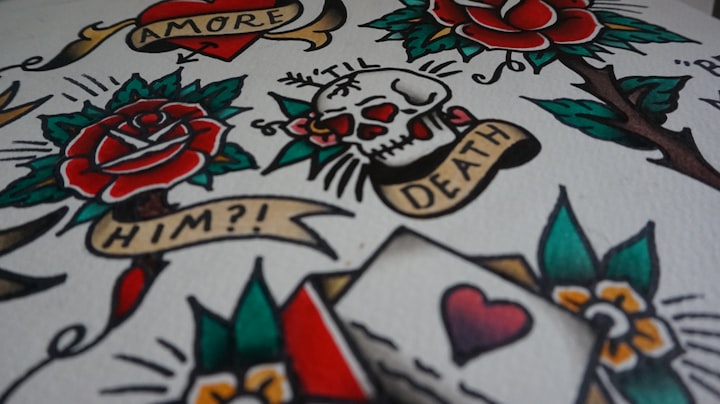
I etched the soundtrack to my life on my skin.
My high school bedroom was neon green, painted with slapdash song lyrics and an accompanying "Like a Prayer" mural painted across the accordion closet doors. What resonated with me most when listening to music was always the lyrics. The jump to turning my love of lyricism into a full-blown cutaneous affair was natural for a wannabe musician with no musical talent that turned to poetry to get it all out.
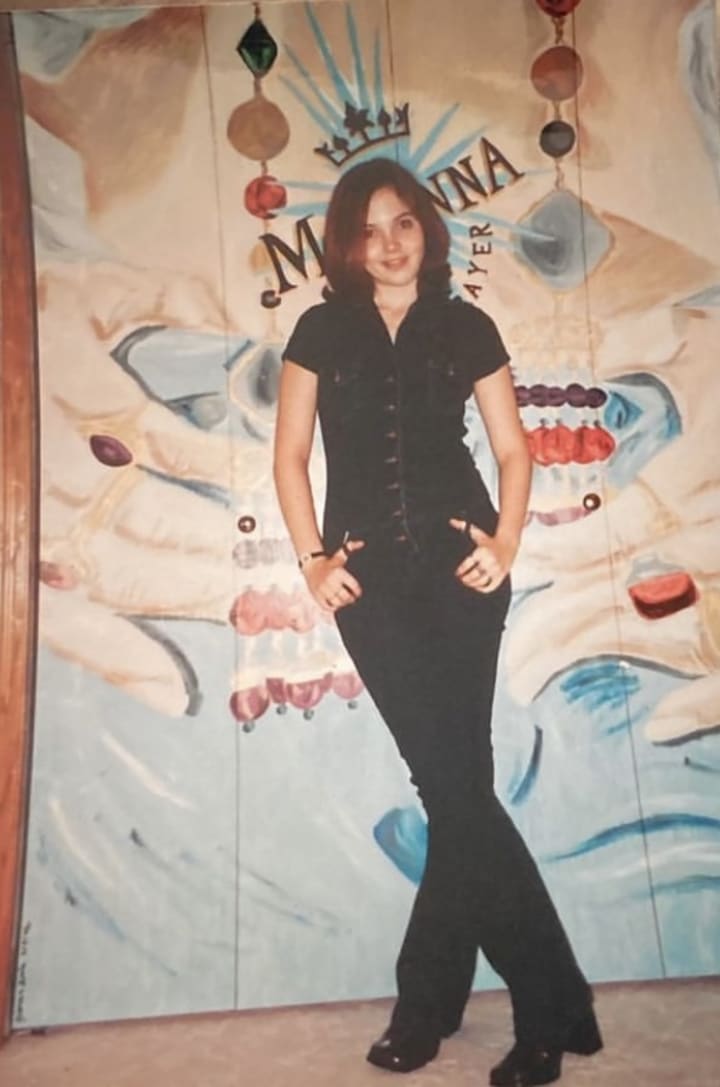
I knew I wanted to be a tattooed person from a young age. The idea that one could wear their story in a personal and permanent fashion appealed to me more than fashion or makeup ever could. I counted down the days until I turned 18 to procure my first piece and chose two days after my birth, Valentine's Day, as the perfect commemorative occasion. At the time, I was listening heavily to the band Eve 6. Their album, Horrorscope, was inundated with rhyme, alliteration, and clever wordplay. I loved the album art drawn by Randy Green. The pop art comic book styling of a woman with her finger drawn to her lip in a secretive shushing motion had me drooling with the possibilities of exploring her world. I wanted her strength, and I wanted her secrets. My older sister is an incredible artist and offered to draw a version of this cover to look more like myself, softer in the face, with green hair instead of blue to commemorate my favorite color. My sister's initials are peeking out of her hairline, a detail I kept in the tattoo. I wanted lyrics to accompany the tattoo and looked to the coy refrain from Eve 6's hit single, "Inside Out."
The same year of this tattoo, at a theatre bonfire, Jason Dammer told me I was a "wannabe slut without the guts." I feigned righteous indignation but knew he had hit the nail on the head. I was a book nerd both insatiably seeking and dramatically uncomfortable with male attention. I grew up idolizing the idea of fetishization and the cult of true womanhood because my upbringing taught me to see my body as the only thing I could control and leverage for attention which was the equivalent of love. These ideals indoctrinated me in ways my teenage brain could not comprehend. I knew sexuality was power, but I was only comfortable with the idea of sexuality, not the act itself. The decision to include the lyric "tie me to the bedpost" from the refrain "I alone am the one you don't know you need/take heed feed your ego/make me blind when your eyes close/sink when you get close/tie me to the bedpost" in the tattoo was a way of yearning for the womanhood I thought would be my destiny. It was the misguided attempt to proclaim I was liberated and in on the joke. It was an homage to music, art, and the intersection of these desires. This tattoo was my proclamation that I was a wannabe slut, and I knew someday I would have to have the guts.
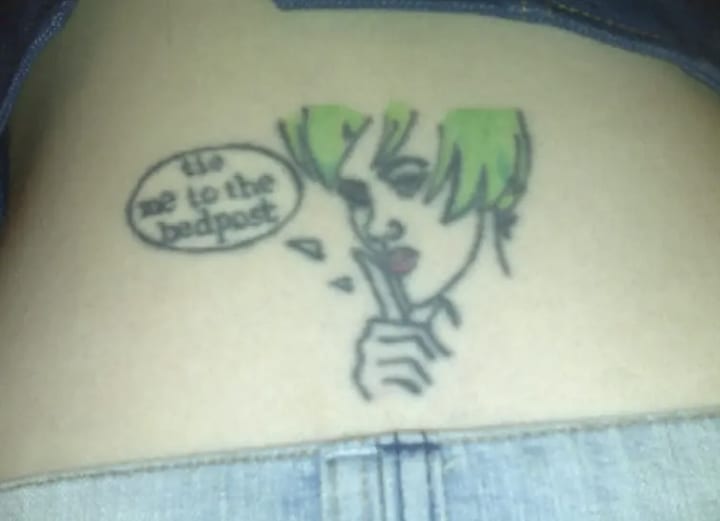
Tori Amos' music entered my life during my sophomore year of high school via Melissa Pierson, who gifted me Little Earthquakes alongside the words, "The song 'China' sounds like something you would write." It transformed me. The artistry of a lone woman and her piano crafting such elusive and ephemeral soundscapes showed me how one could transfer the individuality of experience into the human condition. Her lyrics often strip herself so bare it is as if her music has flayed both artist and listener.
Her post-9/11 sonic tour of America, Scarlet's Walk, came out during my senior year of high school. I used the song "Gold Dust" to underscore my graduation address to the class of 2003 and voraciously sought tickets to the album's namesake tour. One of the central images emblazoning itself on this tour was a woman's face with hair of leaves cascading from her head. I bought the limited edition U.S. leg tour t-shirt and knew I wanted to put the image on my body. I chose the right side of my stomach. It would be my third tattoo. I had discovered early on in my tattooing journey that by tattooing feminine places of my body, I could grow to embrace my body more profoundly. I grew up enslaved to disordered eating culture and was no stranger to starving, excess, and the chaotic grip of control. I wanted to weave lyrics through the strands of hair to stylize the tattoo in a way that made it more unique than just a direct copy. The two songs I chose came from Boys for Pele and From the Choirgirl Hotel.
The first lyric I chose was "honey, do drop in at the dew drop inn" from the song "Muhammed, My Friend," "Muhammad my friend/I'm getting very scared/teach me how to love/my brothers who don't know the law/and what about the deal/on the flying trapeze/got a peanut butter hand/but honey do drop in at the Dew Drop Inn" and the lyric "I'm not Persephone," from the song "Pandora's Aquarium," "I am not asking you to believe in me/boy I think you're confused/I'm not Persephone." To me, these lyrics spoke to the mythos of Tori Amos: the intersections of religion, mythology, and the burning fire of womanhood.
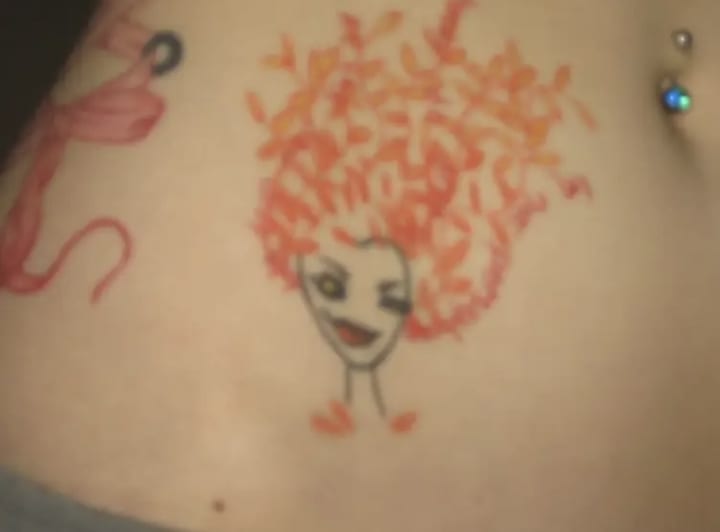
In keeping with tattooing the feminine graces of my body, I next set my sights on the sides of my breasts. I wanted more lyrics and again turned to Tori Amos. Knowing that I existed in an utter dichotomy long before I had a mental health diagnosis, I wanted to highlight the conflict of being both good and evil, compassionate and selfish, sexual and puritanical in measures equal and opposite. For these tattoos, I turned to the songs "Cruel" and "Give." As a proud Southpaw, I wanted the lower, more base version of myself to be on my left side and the better, more saintly part of my ego to grace the right. In "Cruel," Tori posits, "I can be cruel, I don't know why," and in "Give," she declares, "So you heard I crossed over the line/Do I have regrets?/Well, not yet/There are some, some who give blood/I give love." I was appealing to the more fundamental understanding of myself while just beginning to comprehend that I could be both something and nothing, large and impossibly small.
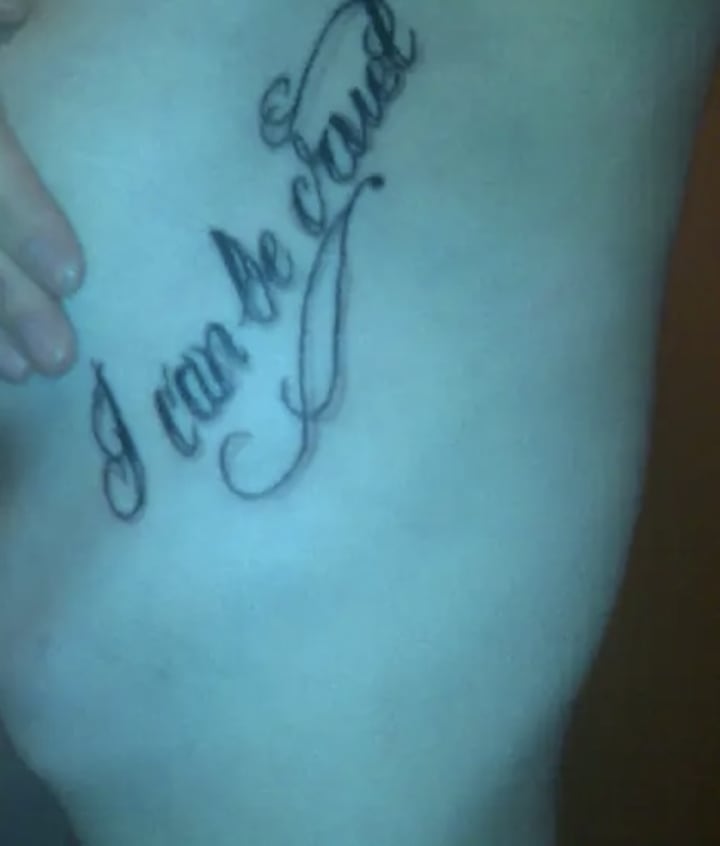
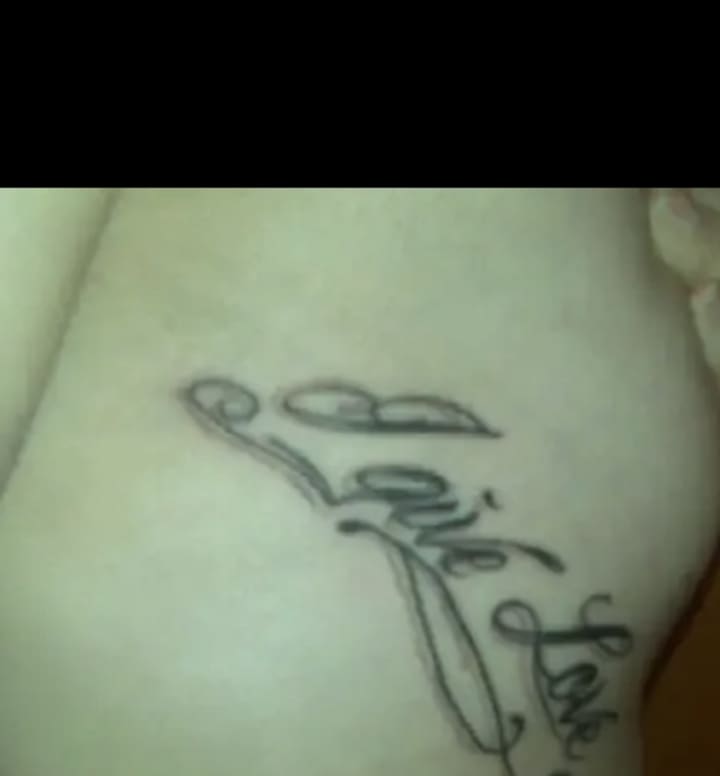
In college, I met my very own Samantha Jones. During freshman year, she gave up her virginity for lent. She was in school to become a pilot and often paired lingerie with camo cargo pants on her way to fly. To be her friend was to inhale confidence in such extraordinary measures as to fly oneself. On the evening of our first dorm social, Amanda was dressed to impress but instead stayed in with me and watched my Tori Amos video VHS collection when my anxiety prevented me from attending. She loved the song "Raspberry Swirl," an homage to female friendship and the strong undercurrents of the need and satisfaction women could find in one another outside of their male counterparts. I took to calling her Beenie, Tori Amos' nickname for the song's inspiration. Our friendship remains steadfast today, as does the pelvic tattoo I inked in her honor, from the lyric, "Things are getting desperate/when all the boys can't be men/everybody knows I'm her friend/everybody knows I'm her man."
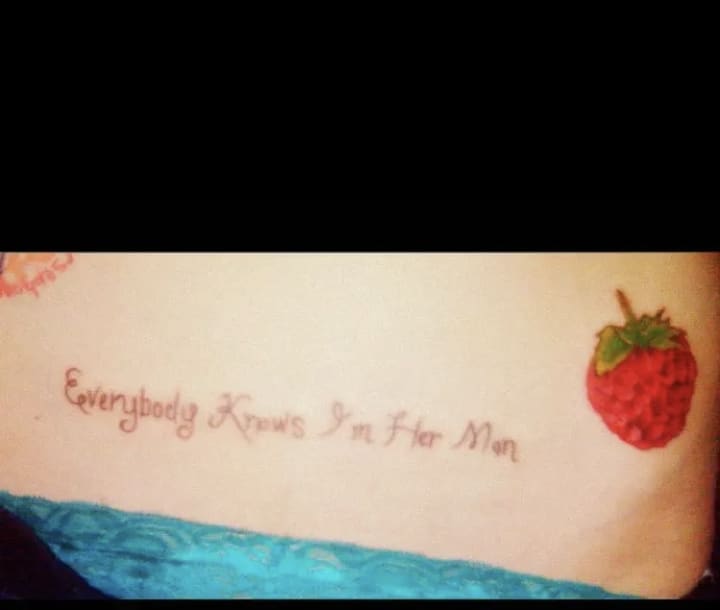
Three years after we graduated college, I found myself in Sioux Falls, South Dakota, and Beenie in Scottsdale, Arizona. I flew to visit her and found myself again immersed in her vapor. We went to a bar where, playing in an abandoned boxing ring, a band named Black Carl swept me away with the sweaty sound of their single, "Hussy." I love etymology and looked up the origin of the words hussy as I burned my fair skin under the blazing sun. I find how we use words to subjugate women utterly fascinating, and I was delighted when I learned hussy originated from the word housewife. It spoke to my experiences as a young woman who felt being larger than life was the only way to take up any small space. I loved the lyrics, "And I keep these old chains around my neck/keep these old chains around my neck until your blood is drawn/'cause any old time/oh no no/I'm always yours/no fussin'/rain, come shine/no no no/I'm always your/I'm always your/hussy."
At this time in my life, with the eruption of my relationship with my son's father, I began to explore what casual sex and casual relationships meant to me. I learned many times, the very hard way, that there is nothing casual about me and how I view intimacy and love. To belong, in being what I felt men both wanted and needed me to be, I was willing to sacrifice myself at the altar of idealism. I was ready to turn my simple, housewife self into a brazen hussy. I tattooed the word, in vivid color, underneath my breast.

While many tattooed people work diligently on sleeves, I began to ink up my legs obsessively. I knew I wanted a large thigh piece to reclaim my meager opinions about my own and, once again, turned to Tori Amos for inspiration. This time, rather than directly inking the words to my body, I wanted a visual representation of a song's ethos. I found inspiration in the Tori Amos cover of the Lloyd Cole and the Commotions song, "Rattlesnakes." The lyrics professed, "Jodie never sleeps 'cause there are always needles in the hay/she says that a girl needs a gun these days/hey on account of all the rattlesnakes/she looks like Eve Marie Saint in on the waterfront/as she reads Simone de Beauvoir in her American circumstance/her heart's like crazy paving/upside down and back to front/she says "ooh, it's so hard to love/when love was your great disappointment."
Amos featured this song on her concept album Strange Little Girls, where she covered songs written by and performed by men from her divine, female perspective. I was a million kinds of broken at this time in my life. I had never recovered from a teenage eating disorder and found great love and pain in a relationship ending in domestic violence. I was outsourcing my self-esteem via the new social media technology and avoiding the truth of my declining mental health. "Rattlesnakes" and the accompanying tattoo were a symbolic outcry for the love I had sought and never found in my adolescence. It was a time of exploring mental illness loudly to proclaim, as the song suggests, "All you need is therapy; all you need is love is all you need."
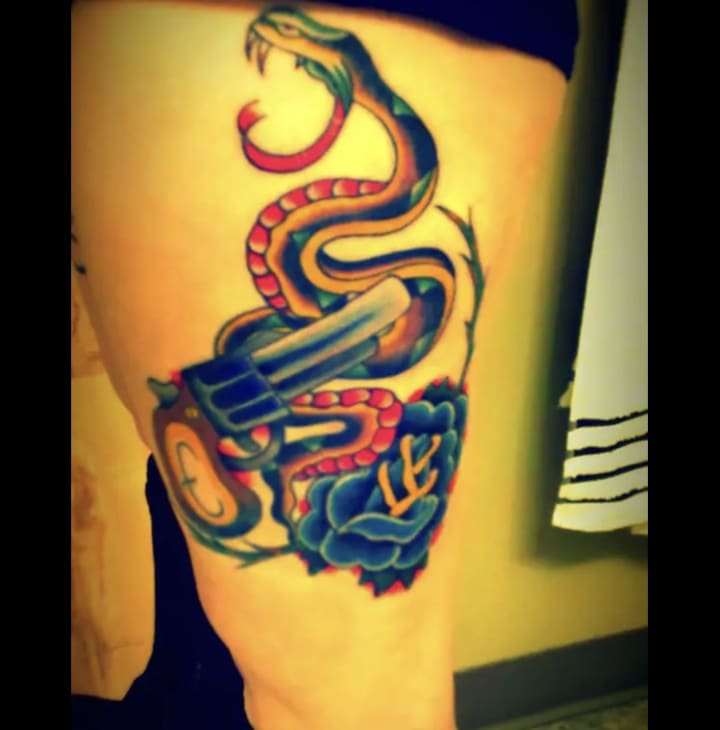
Around 2010, I was dallying with a friend who adored the Minneapolis hip-hop collective Doomtree. We traveled to the cities together to attend their first art show, getting lost in a ghost-hunting expedition site first. When we finally arrived, the performer onstage declared, "I'm the asshole that wears his own merch to perform." I was smitten. I went home, and MySpace friended the rapper. The following day I received a message from him. When I showed my friend over a beer at a dingy booth in a nearly shut-down Old Chicago, he declared, "We are going to infiltrate Doomtree." Thus began the torrid affair of my twenties that took me from my child, my safety, and the last remaining semblance of my innocence.
The rapper compelled me. The words he spewed were an intoxicating perfume, and his talent and eager wit left me thirsty for more. We were both broken, single parents from devastating relationship ends. He was from California, and his eagerness for my name made me feel I was as clever as I had always thought just by my mere existence. I was obsessed with the idea that I could be a muse, that my culture was more than pop, and that I could exist in a world of rhythm and words. In his presence, I tried my first drug so hard it collapsed my frail and anorexic frame. I lived to be a pretty plaything, and I found it glamorous. No one could have warned me of my waning sanity. I tattooed my feet in homage to this time, an ephemeral memory at best, even as it existed.
On my right foot, I etched brass knuckles from the song "Kid Gloves," which included the lyrics "It gets hard doesn't it, like love and war is redundant/both demand strong hands, strong stomachs/I rock brass knuckles over my kid gloves/like you wake up with busted teeth but know you felt real love." My tattoo artist, showing me the sketch, said he had made the knuckles hearts because it seemed like me. I was a simple, love fool, heart on my sleeve kind of damsel, permanently distressed and thinking it was darling. On my right foot, I etched a crow with the word optimist from the song of the same name, "Optimist (We Are Not For Them)." I loved the lyrics, "Someday I'mma be peaceful again/'Til then keep the speech to a min/Shed a little skin, I'mma bet it all and win'/Imma set it off and run, I'mma kill it 'til it's dead/I'mma do it 'til it ain't fun and the words don't come/Then I'm gonna find another hobby/Probably find love, probably find trust/81 young with a little bit of rust." Of all my many tattoos, this was the only time I almost tapped out from the pain, as if my body knew I was a lying pessimist at heart.
As I recall this period, including some of my most passionate and bare-bones writing, I see it as the permanent memories of the many girls I have been as I thirsted for womanhood. I wanted to be coy and clever and craved feeling seen and heard. I became loud on social media, befriending authors and porn stars, pretending my own star was rising. In those moments, I lost my connection to motherhood, the simple existence of a woman doing her duty to the child she bore. It would be easy to regret these memories, but I do not allow shame to be my salve. I operate under the declaration that I would not be the woman I have grown into if I didn't fumble my way there. Past the fast mistakes and staggering lows, I became a sober mother, a compassionate empath, and a creative thinker writing my way out of my own demise. It is with pride that I hear these songs and emblazoned my flesh with these memories. I forgive my younger self. She was optimistic she could be more, that her wounded heart could heal, and the men and myths I crafted along my journey remain etched on the skin like willowing bruises declaring all pain is but memory fading unless its color is vivid enough to wear forever.
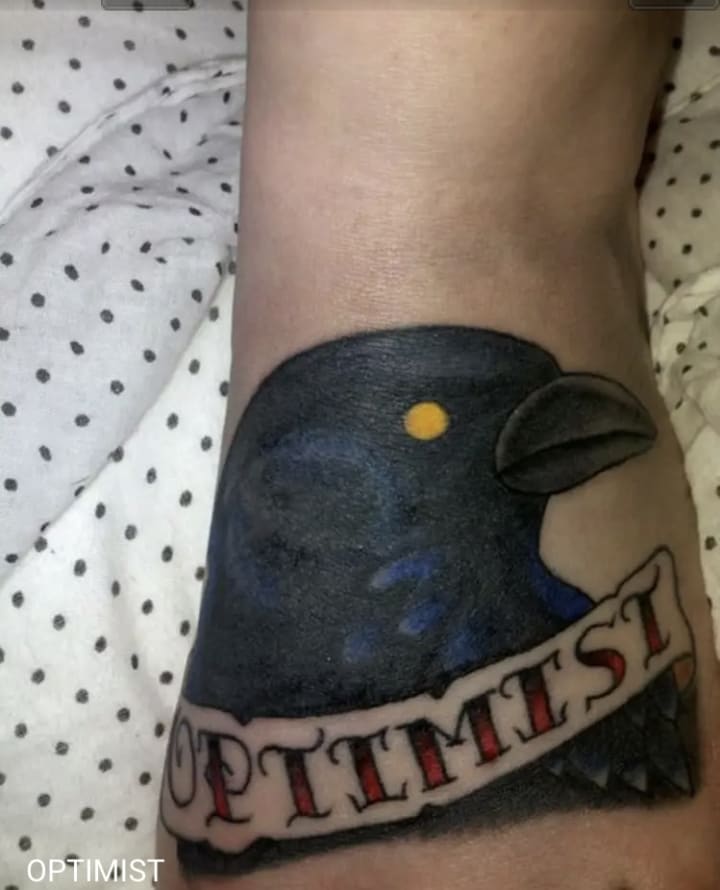
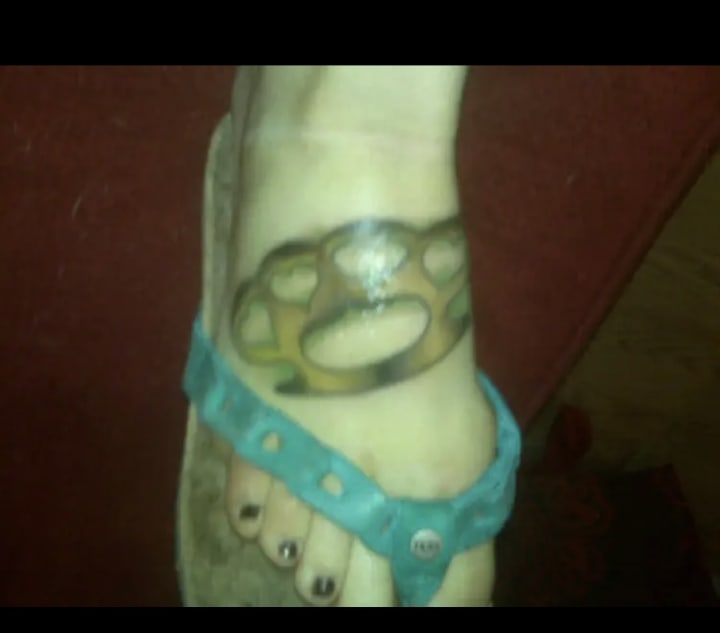
In my late twenties, I listened heavily to independent hip hop, predominantly artists invading the Minneapolis scene. One such artsit was Astronautalis. I loved his lyricism and blend of history and wordplay. In many ways, I was thrill-seeking the close contact high of creativity I had experienced when I was involved with the rapper. Astronautalis was touring for "This is Our Science," and I heavily gravitated toward the song Measure the Globe. In this song, he professed, "So I'll cover my hand in tattoos/I'll kiss any woman that moves/There's no Lord to forgive me and physics is tricky/So all that I'm left with is you." I wanted to tattoo these words on me and decided to take the entirety of the lyric up the back of my leg to resemble a garter seam. If I was going to mimic permanent lingerie, I wanted it to be in words, specifically ones that left me questioning science, religion, and attachment issues that left me wholly incapable of being alone, even if the core of my existence was loneliness.
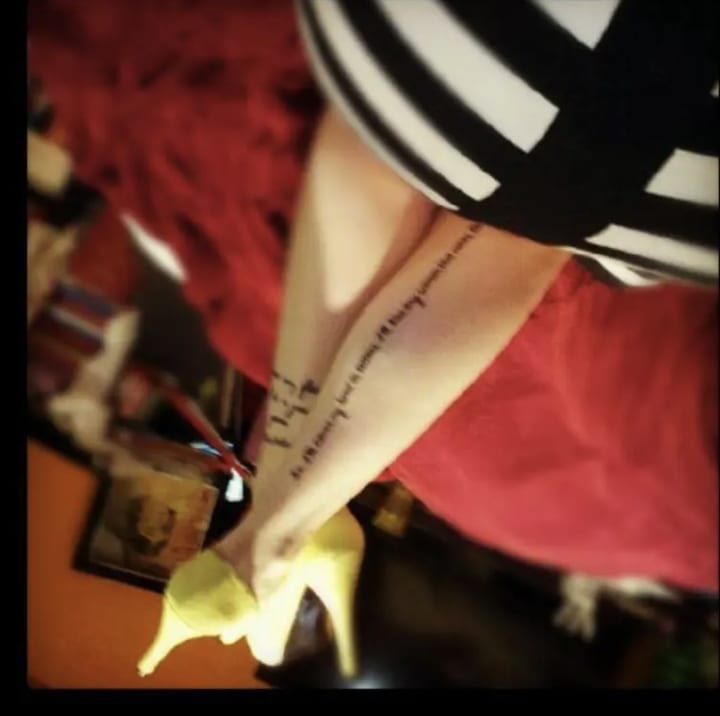
In 2013 my then fiancé took me to my first Kanye West concert. It was the Yeezus tour in Kansas City, Missouri. It was a profoundly moving experience, as I had never seen a show of that magnitude in artistry and scope before. The entire thing, intentionally, felt like a religious experience. I left there a massive fan. I shared this with my fiance and began researching West, fascinated by the intersection of creativity and mental illness/brain trauma between him and a favorite author of mine. When my tattoo artist drew what I have come to refer to as "one of his women" with a solemn expression and the word mercy underscoring her face, I knew she had to be mine. My first interaction with my fiance was over Facebook, discussing the Cruel Summer record. We had gone on to see 2 Chainz the day before we became an official couple and had seen Big Sean perform at Soundset years later. I referred to this tattoo as my Mercy quadfecta referencing our love of hip-hop and the Cruel Summer song Mercy. I missed the chance to see Pusha-T live twice and hoped to finish someday seeing the four artists represented on the track to complete the imposed ideal behind the tattoo. The relationship between my fiance and I ended, it became impossible to separate Kanye West's art from the artist, and I still have not seen Pusha-T. Yet, the lyric "your chick, she so thirsty" remains a missive I continue to harken back to both in music, appetite, and tattoos.
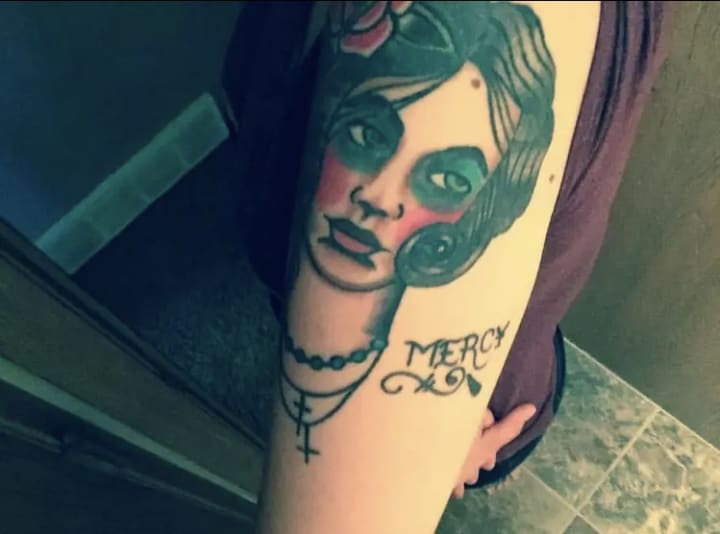
I wanted to tattoo the word thirsty on myself for years. The idea began as a young mother when my son asked for juice I couldn't afford at the coffee shop where I worked, and I vowed to work my way up in my career so that I would never have to deny my child their thirst ever again. This narrative piggybacked on my obsession with the weaponry of words, particularly how we wield them toward women. In the P.O.S. song "Drumroll (We're All Thirsty," he screams that same line, "We're all thirsty," and I found myself intellectualizing how we could all be striving for something while vilifying the idea of a woman getting hers. If a thirst trap is simply bait, why is there no discussion of the predatory pool patrolling the waters? I wanted to shout to the world that I was thirsty, dehydrated even, starved from trauma, and a culture that placed me as both the consumer and consumed and judged me for both. Thirsty began representing even more to me in my thirties as I worked toward recovering from alcohol addiction. If thirst is the brain's way of warning us of dehydration, then the threat of thirst throughout my life was a full-blown signal that I was not watering my roots. In outsourcing myself to men and myth, I grew only toward the sun of others. In sobriety, in reclaiming comfort within my skin and space, I finally learned to breathe, become, and grow.
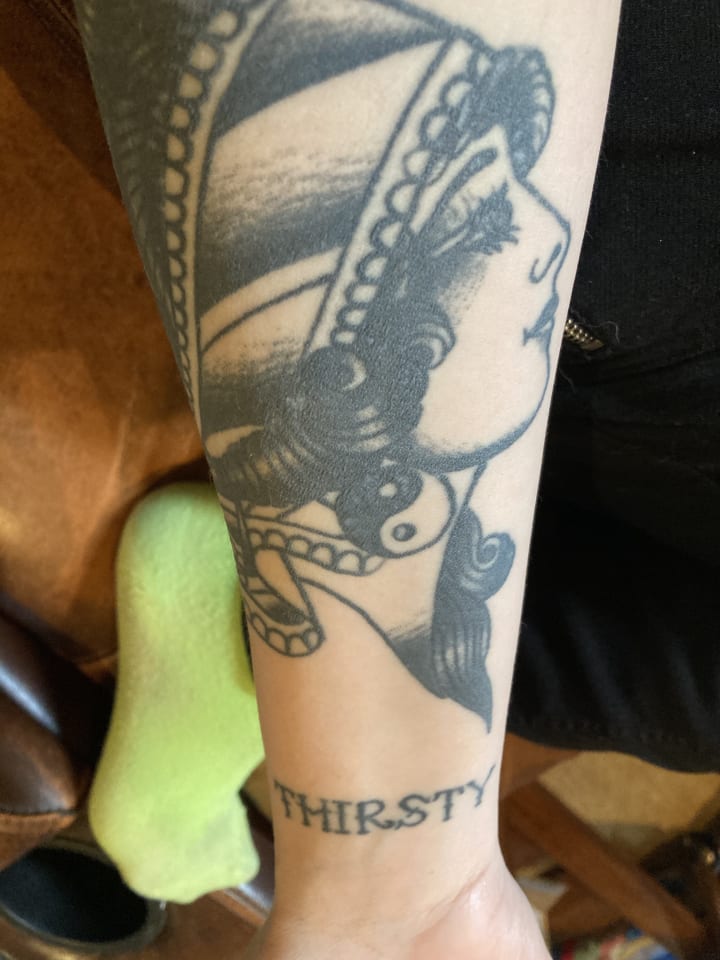
About the Creator
Cali Loria
Over punctuating, under delivering.


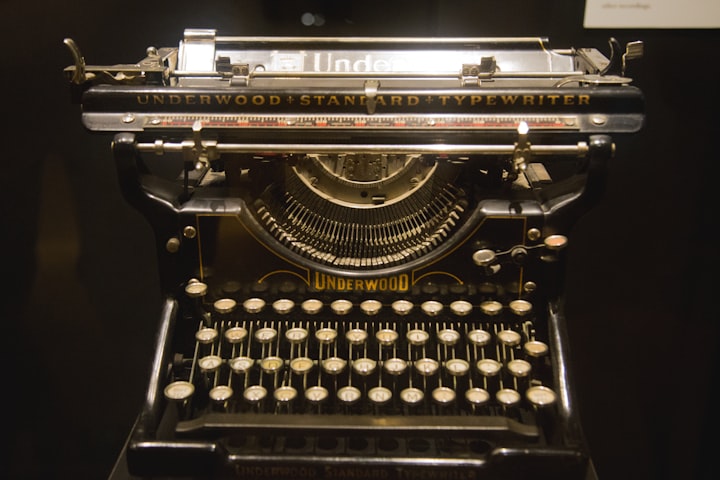

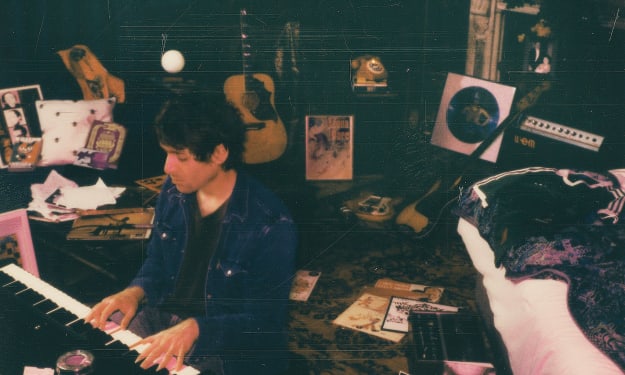

Comments
There are no comments for this story
Be the first to respond and start the conversation.